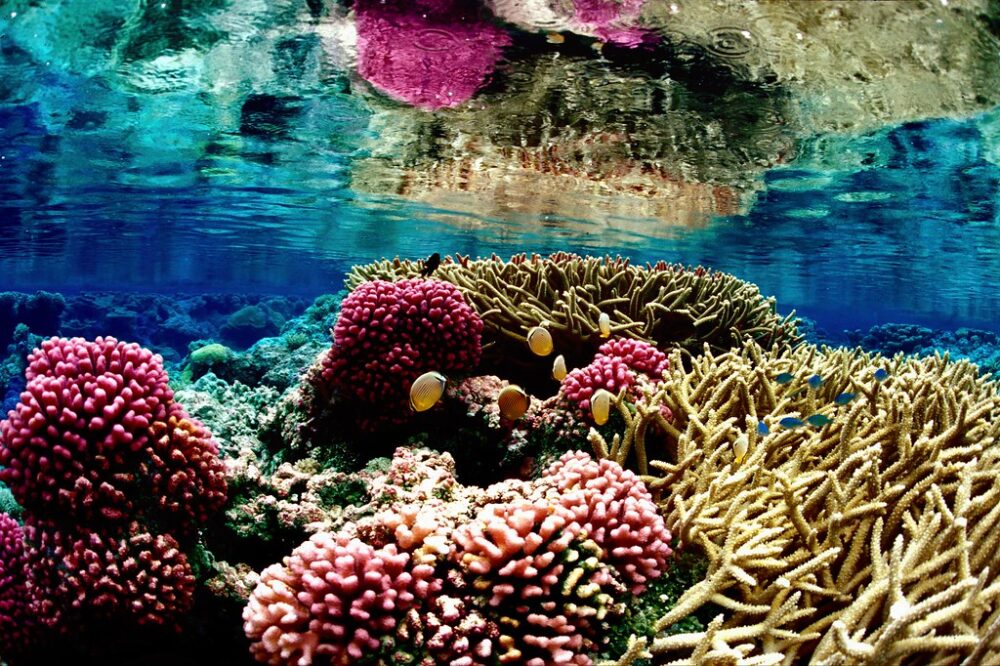Glow sticks are part of a happy childhood memory for many. Beneath your fingertips, you snap the plastic stick in half, revealing a beautiful vibrant color show in the dark. While glowing colors may remind us of nostalgic times, fluorescing corals are a sign of a last-ditch effort to survive bleaching in the battle against climate change.
When corals face environmental stress, such as excess light or increased temperature, they expel the photosynthetic algae living in their tissues, known as zooxanthellae. These algae produce carbohydrates through photosynthesis, providing food that corals depend upon to survive. Once the zooxanthellae have abandoned the coral, the coral appears translucent, revealing the chilling sight of exposed white skeletons. At this point in bleaching, corals can still recover, but if the algae do not return for long periods, the coral is left vulnerable to disease, starvation, and eventually death.
Zooxanthellae require sunlight to photosynthesize, but excessive exposure to light can exceed the algae’s photosynthetic capacity, causing damage and leading to photoinhibition. With damaged photosynthetic machinery and the stress of increased light and temperature, corals are extremely susceptible to bleaching.
Amidst the sea of white, bleached coral skeletons, some have begun to glow vividly, sparking curiosity in scientists around the world. What is this sudden fluorescence, and is there a purpose behind it?
Scientists at the University of Southampton and the University of Western Sydney studied this phenomenon, speculating that these fluorescent colors are from chromoproteins in corals that may serve as a sunscreen-like protective layer. Researchers proposed that chromoproteins act as a layer that screens incoming light, absorbing and reflecting photons away from the algae in coral tissue. One particular study, done by Aanya Salih and a team of researchers at the University of Western Sydney, used two different colors of Acropora valida coral, a brown morph and a purple morph with differing amounts of chromoproteins, to see how the presence of chromoprotein pigments in coral tissue impacts the response of algae to high light stress. At the end of the experiment, coral branches lacking chromoproteins, known as CP pigmentation, showed signs of bleaching, while branches with CP pigmentation did not suffer from bleaching. Coral tissues containing high amounts of chromoproteins in the purple morph experienced much less photodamage than the tissues with fewer chromoproteins present in the brown morph. This indicates that chromoproteins successfully screen out excess light, protecting the algae from damage to their photosynthesizing machinery. Scientists have coined this occurrence as an optical feedback loop.
Chromoproteins act as a layer that screens incoming light, absorbing and reflecting photons away from the algae in coral tissue.
Not only do these fluorescent photoprotective pigments provide a sunscreen-like protective layer to zooxanthellae in coral tissues, but they also could encourage algae to recolonize bleached tissues. The research team from the University of Western Sydney believes that the presence of CP pigmentation in “growth zones” assists in the colonization of new coral tissue by providing photoprotection. As CP pigments mitigate light stress on corals by screening and reflecting photons away, this could draw algae back to corals, assisting in the recovery of already bleached vulnerable corals. Upon return of the algae, the chromoprotein genes are turned off, efficiently saving energy and increasing coral productivity.
Since corals are hidden below the ocean surface, many people are not aware of their importance. Corals protect coastlines from erosion, absorbing wave energy from major storms. They support high levels of biodiversity, provide food and medicines for millions of people, and hold a large economic importance through tourism. Although people may not realize it, the consequences of losing reefs to climate change would be detrimental.
However, do not lose hope. It is not too late for corals. When speaking at the American Museum of Natural History on her research with corals and their fluorescence, Salih said “if we care, as people, about these natural resources, then we can influence what happens to these resources.” If enough people understand how crucial it is to save coral reefs, changing actions can make a difference. Corals cannot survive future climate change on their own solely with their chromoprotein “sunscreen.”
It is hard to miss these neon survival signs that corals have created. This is nature’s way of begging us to take responsibility. Asking us to help corals in their battle against climate change. Imploring us to change our harmful actions before it is too late.
Sources:
Coral Reefs (2013). DOI: 10.1007/s00338-012-0994-9
Current Biology (2020). DOI: 10.1016/j.cub.2020.04.055
The Australian Journal of Agricultural and Resource Economics (2009). DOI: 10.1111/j.1467-8489.2007.00444.x
Image courtesy of Flickr

